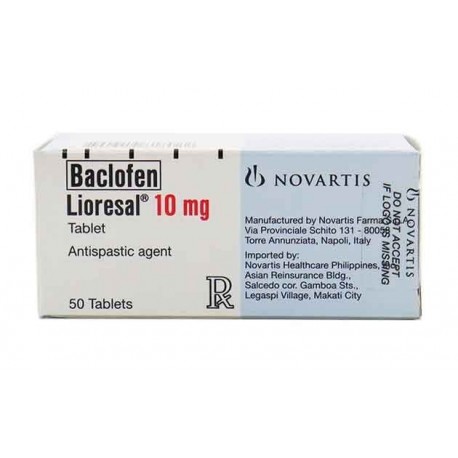 View larger
View larger Lioresal 50 Tablets (Baclofen)
LOR6552
New product
BUY MORE PAY LESS
| Quantity | Discount | |
|---|---|---|
| 2 | 5% | |
| 3 | 10% | |
| 4 | 15% | |
| 5 | 20% |
Volume discounts
| Quantity | Discount | You Save |
|---|---|---|
| 2 | 5% | Up to $2.80 |
| 3 | 10% | Up to $8.40 |
| 4 | 15% | Up to $16.80 |
| 5 | 20% | Up to $28.00 |
More info
LIORESAL 10 mg tablet Taken orally.
Active ingredient
Each tablet contains 10 mg of baclofen.
Excipients
silicon dioxide (Aerosil 200), microcrystalline cellulose (AvicelPH), magnesium stearate, wheat starch, polyvinylpyrrolidone
What is LORESAL and what is it used for?
Lioresal belongs to a group of medicines called muscle relaxants. Each tablet contains 10 mg baclofen.
Your medicine has a package amount of 50 tablets.
LİORESAL is used to reduce and relieve excessive tension (spasms) in the muscles in various conditions such as multiple sclerosis, spinal cord diseases or injuries, and some brain diseases.
LİORESAL increases your mobility, facilitates your daily activities and helps physiotherapy by providing relaxation in the muscles and thus relieving the pain.
3.How to use LORESAL?
Instructions for proper use and dose / frequency of administration
Adults usually begin treatment (preferably with a total of 15 mg baclofen per day, 2-4 times a day). This dose is then gradually increased until the best results are achieved. The resulting dose may be 30-80 mg of baclofen per day (in 2-4 divided doses). Your doctor may even decide to give you a higher dose.
The dose your doctor gave you may differ from the one written here. If this is the case, follow your doctor's instructions. Do not exceed the recommended dose.
Your doctor will tell you exactly how many tablets LIOORESAL to use.
Depending on your response to treatment, your doctor may recommend a higher or lower dose.
If you have been receiving treatment for 6-8 weeks and do not feel any improvement, report the situation to your doctor. Your doctor will decide whether you will continue to use LIOORESAL.
Your doctor will tell you how long your treatment will take with LİORESAL. Do not stop treatment early because you will not get the desired result.
Application route and method
Take LİORESAL with food. Swallow the tablets with a sufficient amount of water (eg a glass). If necessary, you can break the tablet. (Taking LİORESAL at the same time every day will help you remember when to take your medicine.)
Make sure to take this medication regularly and strictly as directed by your doctor. Doing so will help achieve the best results and reduce the risk of side effects.
Use in children
Use in the elderly
Use in the elderly
If you belong to this group, you may experience more side effects. Therefore, your doctor will keep you under observation and can adjust the dose of Lioresal you use.
Special use cases
It has no special use.
People with muscle spasms caused by a brain disease:
If you belong to this group, you may experience more side effects. Therefore, your doctor will keep you under observation and may adjust the dose of Lioresal you use.
If you have an impression that the effect of LİORESAL is too strong or too weak, talk to your doctor or pharmacist.
If you use more LIORESAL than you should
The main symptoms of overdose are; drowsiness, difficulty breathing, problems with consciousness and loss of consciousness (coma).
Other symptoms may include: confusion, hallucinations, persistent restlessness, seizures, blurred vision, unusual muscle relaxation, sudden muscle contraction, weak or absent reflexes, high or low blood pressure, slow heartbeat, rapid or irregularity, low body temperature, nausea, vomiting, diarrhea, or secretion of large amounts of saliva.
If you have used more than you should use from LİORESAL, talk to a doctor or pharmacist.
4. What are the possible side effects?
Like all medicines, people who are sensitive to the substances contained in LIORESAL may have side effects.
These are mostly mild and usually seen at the beginning of treatment; They normally disappear gradually after a few days.
Some side effects can be serious:
Trouble breathing
Confusion (confusion)
• Excessive feeling of happiness
Sad mood (depression)
Loss of coordination that affects balance, walking, arm-leg and eye movements, and / or speech (ataxia symptoms)
• Trembling
Hallucinations (hallucinations)
Having a nightmare
Blurred vision / visual impairment
Shortness of breath, swelling and fatigue in the legs (signs of decreased cardiac output) during rest or activity
Low blood pressure (hypotension)
Skin rash and hives (urticaria)
• Difficulty urinating, painful urination or sudden decrease in urination
Seizures
Blood pain, yellowing of the skin or eyes, and tiredness (signs of liver failure)
Low body temperature
If you have one of these, inform your doctor immediately.
Some side effects are very common:
These are side effects that are likely to affect more than 1 in 10 patients.
Drowsiness
• Sleeping state
Nausea

